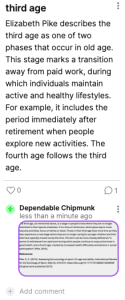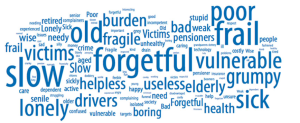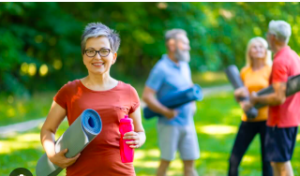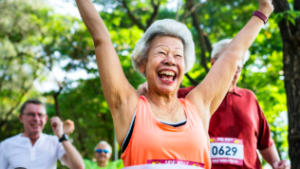6
Section One: The Fundamentals
A) Keywords
Exercise 1:
Provide a brief definition of one of the padlet keywords for this week.


| **** My padlet post is by the ‘dependable chipmunk’, for some reason the formatting got messed up when I tried to copy my response into the padlet.
Response: The third age, as mentioned above, is a stage in people’s lives where they are no longer restricted to their typical schedules. It is a time of retirement, which gives way to more leisurely activities, focus on family or travel. Those in their third age have more time as they also experience a new stage where they are no longer caring for younger children and their kids have typically moved out by this time. The term can be more closely defined as “a period of withdrawal from paid work during which people continue to enjoy active lives in good health; and a fourth age, marked by increased health difficulties and decline in social participation” (Pike, 2015). References Pike, E. C. (2015). Assessing the sociology of sport: On age and ability. International Review for the Sociology of Sport, 50(4-5), 570-574. https://doi.org/10.1177/1012690214550009 (Original work published 2015)
|
B) The Social Significance of Aging in Sport
Exercise 2: Notebook Prompt
How is old age popularly represented today? Find an image online that you think exemplifies one defining attitude towards old age and paste in your notebook below with a brief explanation of what this image means to you.


| The first image above depicts the attitudes towards older individuals as it shows the words used against them. Most people view older people as a drain to society as they are perceived to not contribute financially due to retirement, as well as drain hospital and care resources because of their physical and mental challenges and inabilities. Another piece of media that comes to mind is from Gilmore Girls when Richard tells Lorelai that he feels useless as he is retired. He once worked in an important firm making a lot of money, and no longer offers value to society because he is no longer in this role. I believe both of these pieces of media depict societies’ tendency to define each other’s worth based on the economic and financial value that we bring to the table, which puts older people at a higher risk of judgment and feelings of uselessness. |
Exercise 3: Notebook Prompt
What does the article (referencing another study by Dionigi) mean by its statement that sport can help aging people to simultaneously “accept and resist the ageing process” (572)? Respond by audio or text and find paste two images sourced online into your notebook showing how sport might help aging people to both accept and resist the aging process.


| The article uses this statement to illustrate the positive impacts of playing sports and making physical activity more attainable and accessible to those who are aging. Often, people who age view it as a negative and easily succumb to a lifestyle of very little activity. This reinforces the perception that aging is something that is bad and leads to deterioration, however, as Pike notes, through encouragement and enabling older people to “participate in sports [it] provides an alternative to traditional perceptions of aging as a period of frailty and decline and helps people to negotiate the process of growing older” (Pike, 2015). This further illustrates that growing old is not something bad, it is only perceived as bad, but by introducing methods of physical activities through sports, the perceptions and mental health of aging people will vastly improve. I have selected the first image to show how sports help aging people accept and resist the process as it depicts a group of older people in the group who are together to work out. This shows how they are defying to aging process by participating in something that isn’t necessarily easy, making an active choice to be physical. The photo also shows them laughing together and happy, illustrating the social activities and mental wellness that come from community and joint physical activity. This photo reveals the positive impacts of physical activity, showing how it allows people to accept and resist the aging process. The second photo I chose is of an older woman who ran a marathon for the first time. Her efforts showed researchers that “first-time marathon runners who trained for 6 months saw a 4-year reduction in arterial age” (Eichenberger-Archer, 2022). This illustrates both the acceptance and resistance of aging as people who are physical as they age show slower rates of aging, resisting the process, but also don’t allow their age to deter them from participating, showing the acceptance of their age as well.
References Eichenberger-Archer, S. (2022, February 9). First-time marathon training has anti-aging effect. IDEA Health & Fitness Association. https://www.ideafit.com/first-time-marathon-training-has-anti-aging-effect/ Napchi, D. (2024, July 18). The benefits of starting a new sport as an older adult. Aviv Clinics USA. https://aviv-clinics.com/blog/wellness/the-benefits-of-starting-a-new-sport-as-an-older-adult/ Pike, E. C. (2015). Assessing the sociology of sport: On age and ability. International Review for the Sociology of Sport, 50(4–5), 570–574. https://doi.org/10.1177/1012690214550009 |
Exercise 4: Notebook Prompt
Who are the groups less likely to have extensive opportunities to take part in sports, according to Pike? How does privilege factor into aging and sport? (200 words max)
| According to Pike, people who have disabilities cannot participate in normative games. Also, those who are frail have less opportunity as this can prevent participation in rough and aggressive games. Ethic and minority groups have significantly less access as well as those who have to live in “care facilities and those living in rural areas” (Pike, 2015). These are issues present as research typically puts the main focus on “white middle-class people, and we know little about the experiences of black and minority ethnic people or those who often lack material resources to understand the meanings they give to their experiences of sport in later life” (Pike, 2015). This occurrence illustrates how privilege factors into age and sport since there is not much research or focus on minority groups, they miss out on all of the health benefits that come from physical activity through sport. If research solely focuses on the white and middle class, those who are not in that group are inadvertently denied the opportunity to experience resisting and accepting age as there are no resources and facilities catered to their needs.
References Pike, E. C. (2015). Assessing the sociology of sport: On age and ability. International Review for the Sociology of Sport, 50(4–5), 570–574. https://doi.org/10.1177/1012690214550009 |
Exercise 5: Padlet Discussion
Why do you think age discrimination is “reported more than any form of prejudice” with older people presented as a threat to social values and interests? Feel welcome to use video in your responses. Paste your comments (or transcript of your video) below!

I believe that age discrimination is reported more than any other form of prejudice as it is not taken as seriously as other forms such as racism, sexism, or classism. I often hear people complain about older people or if someone older bothers them, their first response is to call them old and make fun of their age. No one really defends older people either, which I am not sure why, but if made a guess, I would think it’s because of their shorter life span. Because of the shorter time they have left to live, most people don’t see any reason to try to help or improve the older generations circumstances. While this is not an okay way to view this group of people, I feel it is very common. I also think that people view older people as a ‘drain’ of our resources as they often need more familial care, hospital visits, and old age homes. Because of this ‘drain’ on resources and time while in retirement and not financially contributing to the economy, people find it easier to brush them off. Since our society values work and money, those who don’t contribute to either or brushed off as somewhat useless. While it’s likely that this is a subconscious attitude, it is very much prevalent within our society towards to older and aging generation. |
B) Older Women and Sport
Exercise 6: Notebook Prompt
What differences do you see in these ads? Which one is more inclusive? How is age represented or not represented in each? Answer these questions in your notebook.
| I believe the first ad by Nike, You Can’t Stop Us (2020) is much for inclusive than the second one. This ad showed people of all races, genders, and sexualities working together. It gave an illustration of each person’s abilities, not allowing societal views to stop them from doing what they love, while also showing the difficult side of sports, where you don’t always win and sometimes, no matter how hard you try, you can fall and hurt yourself. It gave a great representation of acceptance, triumph, hard work, and dedication while including people of all groups by showing the similarities throughout. However, this ad did not include one representation of old age, so this is where Nike falls short. The second ad, This Girl Can – Me Again, is much less inclusive as it shows a very female experience. However, while it only shows women and women-based struggles such as menstrual pain and taking care of family, it does show many different body types, races, and struggles experienced by different women. However, similar to Nike, this ad didn’t have any old-age representation. Thus, falling short as well. |
Exercise 7: Notebook Prompt
In her article, “Assessing the sociology of sport: On age and ability,” Elizabeth Pike references a “trend towards a ‘feminisation of ageing’, with many women living longer than men” (573). Do you agree that aging has been “feminized” in this way? How? Answer these questions in your notebook.
| I do agree with the stance that aging has been feminized, as Elizabeth Pike states “with many women living longer than men” (Pike, 2015). This means that the views and perceptions of aging are viewed more through a female lens, and with women being a neglected gender of study, their struggles and abilities through age are ignored by researchers. Elizabeth Pike also mentions that with aging, since a large population of older women outlive men, “gender has been traditionally neglected as a focus for analysis” (Pike, 2015). Societal pressures and views of women also should be taken into consideration as the expectations on women are much higher, which impacts their physical and mental health through its prohibition of women’s participation in sports. This is apparent as “physical activity levels among women decline significantly in later life, in part due to societal expectations to maintain their role as carers for grandchildren and their own parents” (Pike, 2015). Thus, I do agree that aging has been feminized largely due to the abundance of living, older, women compared to men, which has led to poor perceptions and struggles faced by older women due to a lack of research and focus.
References Pike, E. C. (2015). Assessing the sociology of sport: On age and ability. International Review for the Sociology of Sport, 50(4–5), 570–574. https://doi.org/10.1177/1012690214550009 |
Section Three: Module Mini Assignment
| *** Did major assignment option instead |

